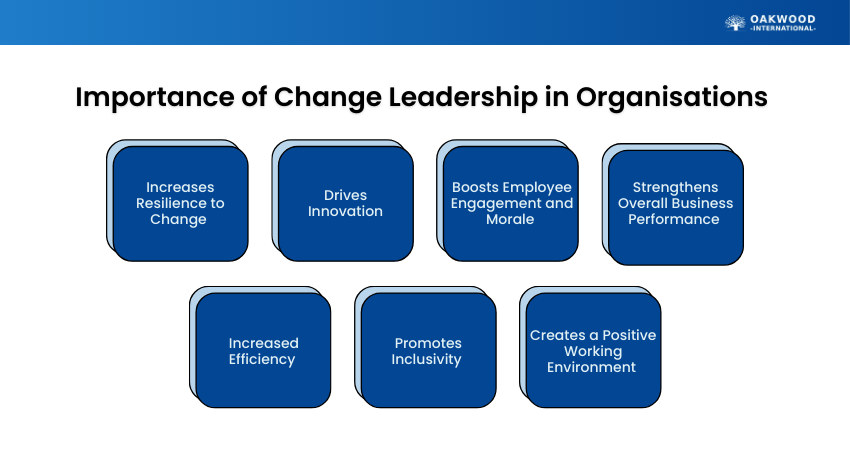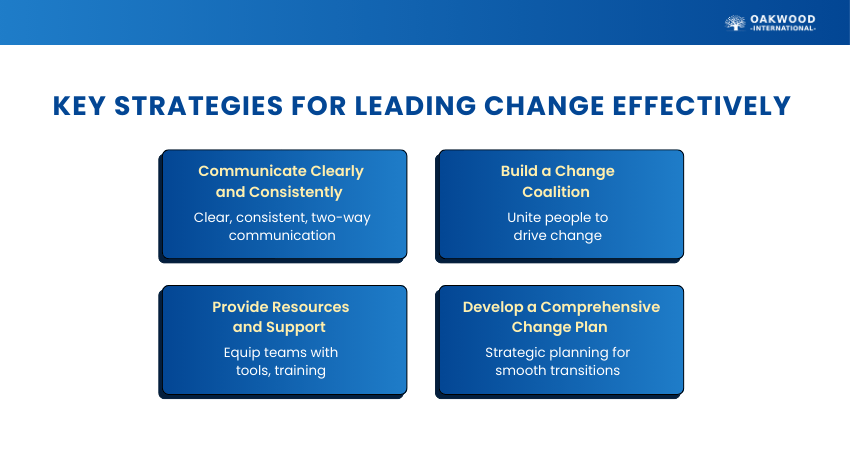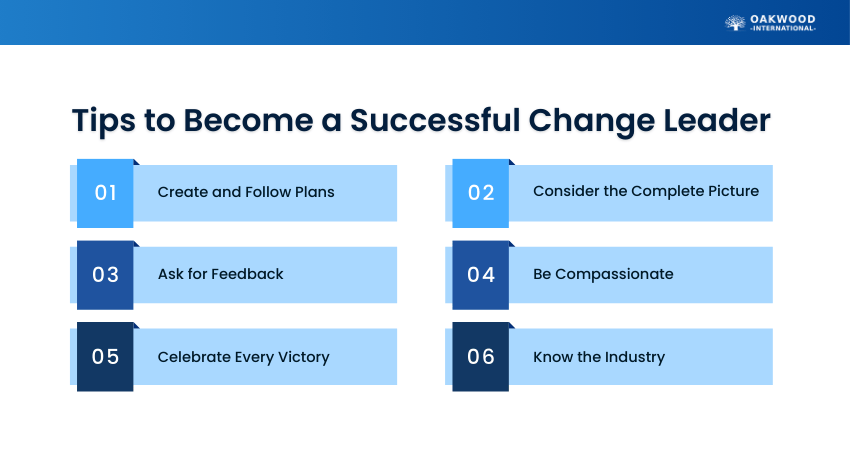Table of Contents


Are you leading change, or is change leading you? In a business world where markets shift overnight and technology advances at lightning speed, the ability to lead people through transformation has never been more important. Without strong leadership, even the best strategies can fail to deliver results. This is where Change Leadership comes in to help organisations not only survive change but thrive through it.
In this blog, we’ll explore What is Change Leadership, why it matters, and the key skills and strategies required to lead change effectively in any organisation. Let’s dive in to embrace the changes with wider perspectives!
Table of Contents
1) What is Change Leadership?
2) The Importance of Change Leadership in Organisations
3) Key Strategies for Leading Change Effectively
4) Essential Skills for Change Leaders
5) Challenges of Change Leadership
6) Tips to Become a Successful Change Leader
7) Real-world Examples of Change Leadership
8) Conclusion
What is Change Leadership?
Change Leadership is one of the leadership styles that focuses on the ability to lead people during organisational changes, disruptions, or transformations. While Change Management focuses on the processes, systems, and steps to implement change, Change Leadership is centred on the human side. It helps people understand, accept, and adapt to the changes.
The most effective Change Leaders can clearly communicate the vision, set clear priorities, and actively listen to feedback. By focusing on people, Change Leadership ensures that transformation efforts lead to lasting success.
The Importance of Change Leadership in Organisations
Effective Change Leadership makes it easier to handle new challenges and become successful. Here is why Change Leadership is important:

1) Increases Resilience to Change
Instead of seeing change as a disruption, Change Leadership views it as an opportunity. With the right processes and strategies, it helps make smoother, less stressful, and more predictable transitions for everyone involved.
When there are Change Leaders, employees can handle uncertainty better. Because they will explain why change is needed, and this makes people face challenges with confidence.
2) Drives Innovation
Change Leadership is valuable not only when there is something to change, but also during stable periods. Every innovation comes with some changes. So, it needs a safe place for people to share new ideas without thinking about failure. It is possible when there is strong Change Leadership.
This is because it encourages creativity and helps the organisation grow. Skilled leaders are capable of embracing change and encouraging new ideas and risks.
3) Boosts Employee Engagement and Morale
Change Leadership is mainly built on communication and transparency. When employees understand why a change is happening and how it will affect them, it will become easy for them to trust and feel connected to the organisation.

Even in stable times, that trust strengthens employee satisfaction and a sense of belonging. It becomes easier to maintain employee engagement and performance when change happens.
4) Strengthens Overall Business Performance
Business changes are often aimed at improving results. Effective Change Leadership ensures changes are implemented with a positive impact. By aligning people, processes, and goals, leaders help not just adapt but also thrive during transformation.
Apparently, when change is managed well, work continues smoothly. Projects will be finished on time, new systems will work well, and the goals will be achieved faster.
5) Increased Efficiency
Change Leadership helps make work faster and smoother. It can be anything, like using machines or software to reduce mistakes, getting new tools to save time, or changing workflows so tasks are done in a better order. Leaders make sure these changes happen quickly and with less disruption.
It also helps employees understand and adjust to new ways of working without confusion. This means there are fewer delays or problems during the change.
6) Promotes Inclusivity
An inclusive workplace makes it easier for everyone to take part and work together. It involves offering flexible work hours, better accessibility, or enhanced leave policies. By understanding and respecting different needs, leaders create an environment where all employees can contribute and succeed.
An inclusive workplace also attracts more people from different backgrounds. It helps to attract and bring fresh ideas. It helps teams work better together by building understanding and respect.
7) Creates a Positive Working Environment
A positive attitude is an important part of Change Leadership. When leaders stay hopeful and care about employee well-being, it creates a good atmosphere at work. This can include using supportive work methods, recognising achievements, and addressing employee needs, leading to higher morale and motivated teams.
Moreover, a positive work environment also makes people more collaborative and creative among team members. Employees are more confident to take action when they feel supported.
Lead teams and improve workplace productivity with our ILM Level 3 Certificate in Leadership and Management - Register today!
Key Strategies for Leading Change Effectively
Let's check some of the key strategies to lead teams through change effectively:

1) Communicate Clearly and Consistently
Communication is the base of every successful change. Leaders need to explain the reasons for change, its benefits, and the expected outcomes. Regular updates through meetings or emails keep stakeholders and team members informed and engaged.
Communication refers to both speaking and listening. Therefore, two-way communication helps to actively listen to feedback, address concerns, and adapt one's approach.
2) Build a Change Coalition
Major change requires collective effort. In order to support and promote the change, the Change Leaders bring together a group of influencers, managers, and team members who believe in the change and help accelerate adoption.
This group can act as ambassadors, spreading positive messages, addressing concerns, and supporting employees through the transition.
3) Provide Resources and Support
People are more likely to adapt to change when they feel prepared. For that, the Change Leaders need to ensure that employees have the required training, tools, and guidance to succeed in the new environment.
This includes offering mentorship, technical support, and ongoing assistance to help individuals perform at their best during the transition.
4) Develop a Comprehensive Change Plan
A strong plan helps you stay on track and also provides clarity. The change plan should define clear objectives, timelines, responsibilities, and outline specific actions needed to achieve the desired outcome.
Leaders must also assess potential risks and adjust the plans to handle unexpected challenges. This ensures that your plan stays relevant and effective throughout the process.
Improve performance and boost teamwork with our ILM Level 4 Award in Leadership and Management – Join now!
Essential Skills for Change Leaders
To drive change successfully, leaders must develop a strong set of Change Leadership skills. These skills are essential for guiding teams through transformation, and we’ll explore them in detail below.
1) Effective Collaboration
Change works best when people feel involved. So, Change Leaders bring teams together to share ideas, solve problems, and help make decisions. This teamwork motivates employees because they feel part of the change and are more likely to support it.
2) Strong Determination
Change often faces resistance, setbacks, or delays. Determination helps leaders stay focused on their goals and keep going, even when there are problems. A determined leader stays positive and confident, which encourages the team to keep trying until the change succeeds.
3) Clear Communication
Change Leaders should be excellent communicators, capable of explaining complex ideas in simple terms, actively listening to concerns, and adapting their style to different audiences. Transparent communication reduces confusion and builds trust.
4) Optimism
A positive outlook makes a big difference during change. When leaders are optimistic and confident, they inspire the same in others. This raises morale, keeps people engaged, and transforms challenges into opportunities.
5) Curiosity
Curious leaders are open to new ideas and better ways of doing things. They ask questions, explore new methods, and look for feedback. Curiosity helps them learn, adapt, and improve the change process. This makes it easier to find solutions and grow as an organisation.
Challenges of Change Leadership
Even the most skilled leaders face challenges during a change. Here are some of the challenges that might happen in Change Leadership:
1) Lack of Alignment
If leadership teams are not united in their vision or approach, employees may receive unclear messages. This can lead to confusion, lack of trust, and slower adoption of change. Ensuring alignment keeps the organisation moving in the right direction.
2) Insufficient Resources or Support
Without the right resources, such as funding, technology, or skilled employees, change initiatives can struggle to succeed. Leaders need to address the support needed to implement changes effectively. This ensures teams have what they need to change effectively.
3) Resistance to Change
People often resist change because of fear, uncertainty, or a lack of understanding. Effective Change Leaders address this by listening to concerns, providing reassurance, and involving stakeholders in the process.
Discover how to set clear goals and motivate team members with our ILM Level 2 Certificate in Leadership and Team Skills – Sign up soon!
Tips to Become a Successful Change Leader
Good Change Leadership can help a business grow, adapt, and work better. Here are some simple tips to lead change successfully and keep your team motivated:

1) Create and Follow Plans:
Make a clear plan before adapting to the change. Use tools like timelines or project boards to track progress, set priorities, and meet deadlines. A good plan can help your team stay focused.
2) Consider the Complete Picture:
Look beyond the short-term results and think about how changes will affect the whole business in the long run. This includes employees, daily work, shareholders, and the resources needed.
3) Ask for Feedback:
Always look for ways to improve. You can ask for feedback to check what is working and what needs to be changed. Being open to suggestions builds trust and improves results.
4) Be Compassionate:
Change can make people feel uncertain or worried. Support your team as required so they can adjust more easily. Showing care helps people feel valued and confident during change.
5) Celebrate Every Victory:
Even small wins matter. Celebrate them with positive feedback, thank-you notes, or small team events. This keeps the team’s energy high and makes people feel appreciated.
6) Know the Industry:
Stay updated on trends and what the other leading companies are doing. This can give you new ideas and help your business adopt useful changes early, keeping you ahead of competitors.
Real-world Examples of Change Leadership
Some of the real-world examples show how Change Leadership can transform an entire business and shape its future. So, let’s check some of them:
1) Netflix's Shift
Netflix started as a DVD rental company, but through effective Change Leadership, it transformed into one of the world’s leading streaming platforms. Leaders foresaw that customers would soon prefer online streaming over renting physical DVDs.
By embracing technology and adapting to what customers wanted, Netflix made a successful shift to digital streaming, allowing it to stay ahead of industry trends.
2) Amazon's Evolution
Amazon began as an online bookstore, but it was turned into a global e-commerce and technology company with the techniques of Change Leadership. By focusing on customer needs and long-term innovation, leaders guided employees through continuous evolution and diversification.
Eventually, Amazon introduced services and products like Kindle, Amazon Prime, and AWS, which transformed online shopping and made Amazon a major force in many industries.
3) Apple's Transformation
Apple’s revival under Steve Jobs is a classic example of Change Leadership. When he returned to Apple, he turned it from a computer company into one of the world’s biggest consumer electronics brands. He saw the chance to create innovative products that fit into people’s lives.
With products like the iPod, iPhone, and iPad, Apple changed industries and set new standards for design and technology.
Conclusion
Change is a constant part of business, and how it is led can make the difference. Therefore, Change Leadership is a lot more than managing processes. It is about guiding people, building trust, and turning challenges into opportunities. With the right skills and mindset, Change Leaders can help their organisations grow, innovate, and stay competitive in a fast-changing world.
Equip with advanced management techniques and strategic planning with our ILM Level 3 Training – Begin to excel now!


 Back
Back



 Back to Catagories
Back to Catagories





 + 44 7452 122728
+ 44 7452 122728










